
Tag Management
Tag management enjoys increasing popularity and a growing community. Most modern websites can no longer manage without a tag management system anymore, so that by now about 30% of all websites use a tag manager.
But this is a quite recent marketing technology trend.
During recent years, a transforming new sector of tag management solutions has emerged. Even until today new solutions enter the market, due to changing regulations and evolving marketing technology.
A good illustration of the growing interest is the worldwide search for "Google Tag Manager" (GTM) - the most popular tag management system (TMS) with a market share of 94% usage distribution on the entire internet:
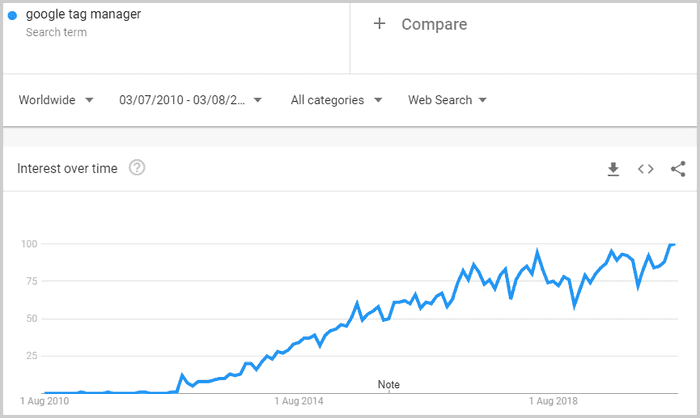
Though the extreme growth has been going on for a while now, tag manager usage is estimated to continue growing with an annual growth rate of 5.7% up until 2024.
What is a tag management system?
A tag management system is a JavaScript library to implement and configure analytics and marketing tags.
HTML tags, JavaScript snippets or tracking pixels add features to your website or app and can be installed with just a few clicks.
Examples for tags
- Google Analytics tracking
- Video tracking
- Retargeting pixels (Facebook, Google Ads, Linkedin etc.)
- Sign up forms
Tag implementations can be done through a graphical user interface (GUI) for easy installation.
After a tag is published to the container, the code will be generated and added to the website’s page (DOM). No new source code is deployed to the server.
The most popular TMS is Google Tag Manager. It comes with a variety of tag types and templates available for third-party providers so you can implement tags just with a few clicks.
The implementation is based on 3 components:
- Tags (code to be added to the page)
- Triggers (rules with conditions that say when the tag is supposed to fire)
- Variables (dynamic data to be used in tags or triggers)
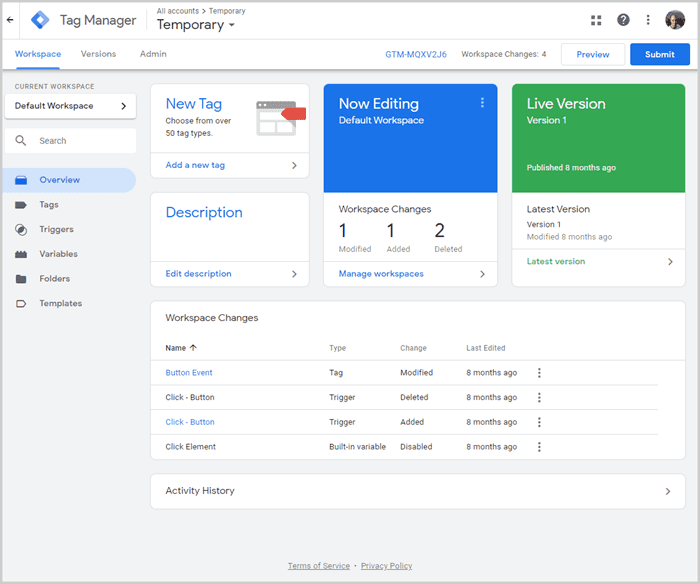
The configuration is carried out with simple forms and input fields instead of having to code it.
This reduces mistakes and makes the implementation of website tags accessible to digital marketers without a programming background.
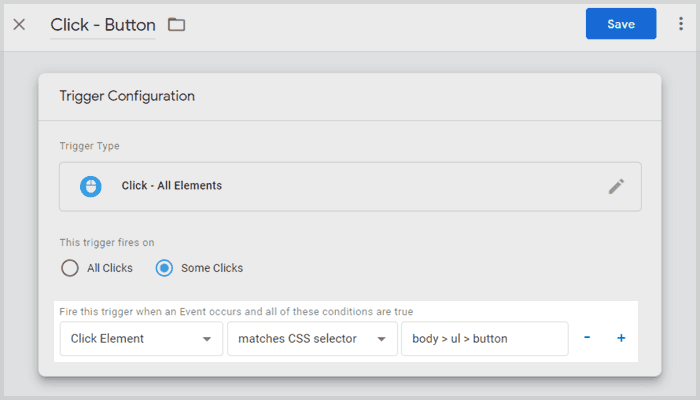
What problem does a TMS solve?
With the web 2.0 and improving marketing technology, new opportunities for digital marketers have emerged. They have made it possible to analyze user behavior for segmentation and use the data for advertising campaigns.
In order to run such targeted campaigns multiple tags or pixels had to be put on the website first. Afterwards, the tracking pixel can categorize visitors and their behaviour to remarket to them on Facebook or Google Ads.
Over time, more social media platforms have come up with their own tags (Linkedin, Snapchat, Twitter, Pinterest, Instagram, etc.) and websites have become bloated with their snippets.
It became not uncommon to see 20 to 40 individual tags in the <head> section of a page.
The foundation for this tagging system is a well-configured event tracking setup. All relevant buttons have to be equipped with JavaScript functions. Once an element is clicked, the JavaScript will notify the relevant marketing tag.
The tags mostly required the same user metrics, but if you wanted to add another dimension or metric it quickly became a cumbersome manual task. So the management of these tags alone became an even greater problem.
So developers had to spend many hours pasting JavaScript code into HTML elements. Knowing how exactly the code should be written or what variables could be sent along became a new organizational task.
Companies that wanted to run campaigns frequently had to set up event tracking on any new landing page to keep campaign tracking running. Keeping master tags, parameters and variables maintained and in line with updates became an additional task.
Any experimential idea of tracking a new interaction became an effort hard to justify. Code-changes became too labor-intensive.
In short, changes and experimenting was hard and unflexible. But conversion tracking had to be maintained to measure campaign performance. Not measuring it properly would otherwise make it hard to improve.
As a result, companies had an increase in web development costs. The problem could only be solved with self-written libraries, which sadly led to developer teams solving the problem in silos, reinventing the wheel
The market was ripe for innovation.
Tag managers solve these problems because implementations can be scaled and thus save time, which means that companies can save money.
Ironically, a tag management system is also implemented through a container tag on all pages. However, any later tags can be added via the TMS itself.
The tag manager code has to be added and deployed only once at the beginning and any following tags are implemented through the graphical user interface of the tag manager tool.
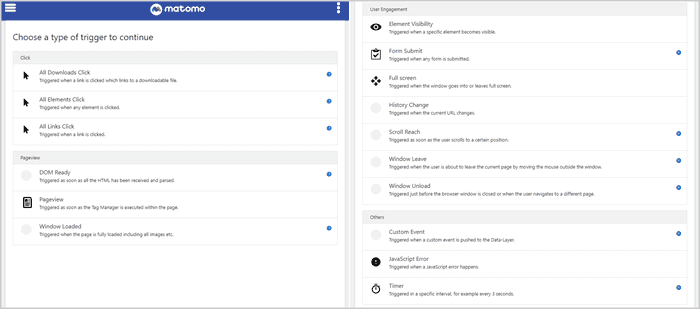
The workload is reduced and the procedure greatly simplified.
Through the simplified implementation, tag management consultants could then configure the data collection of tracking tags. This new role in the organization focuses on JavaScript programming solely for web analytics and digital marketing services.
Every rule and every data point could now be used across multiple tags and even across multiple domains.
A tag management platform has many advantages. So many in fact, that you rarely hear any complaints.
Advantages
One of the great benefits of tag management systems is that a technical marketer can implement marketing tags without being dependent on a developer.
The graphical user interface makes it easy for a digital marketer to perform basic implementations that would otherwise be too difficult in raw code.
As an example, here is the list of marketing tools and analytics tags you can install with Matomo Tag Manager:
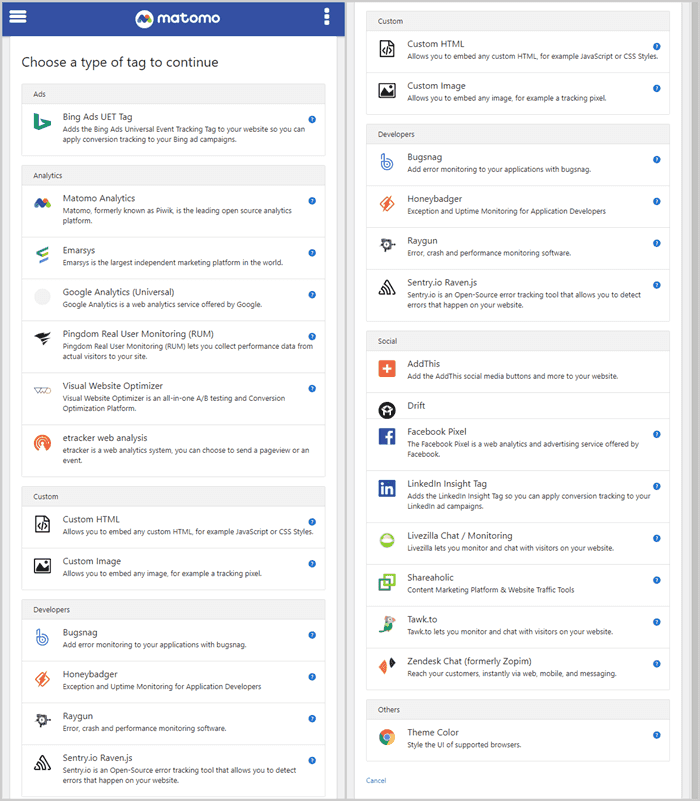
Below you see a list of GTM's available tag options (complete list of supported tags). In comparison, GTM has the most tag templates available as well as custom templates.
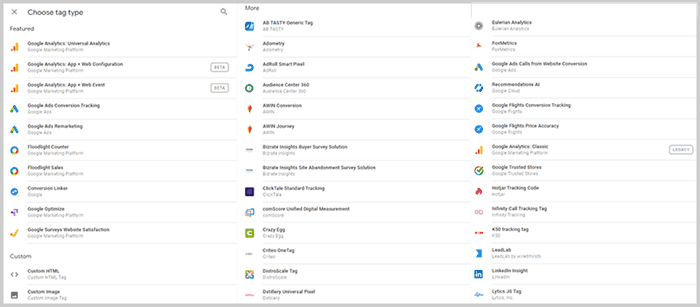
Since tag deployment occurs in seconds and a marketing team no longer has to wait for code deployment on the server, using a TMS saves time, costs and reduces overhead project management.
This is confirmed in a 2015 report by Econsultancy, where 73% of marketers said that using a TMS helps reduce costs.
With this flexibility, agile workflows are possible that allow for gradual campaign optimizations, tests and experiments.
Digital marketing campaigns can be run in more varieties while targeting more specific groups, which increases conversions and provide a good foundation for learning how groups respond to custom messaging.
Companies that already have data silos available, like databases, CRMs and APIs can use a data layer to make the data available for campaign tracking rules.
Another underestimated advantage are the available settings for workspaces, environments and user rights that form a management solution to provide access to agencies or external consultants. Access can be granted in seconds to let somebody work on an individual tag or the whole tagging plan.
In summary, the advantages of tag management are as follows:
- Cost-savings, due to lower implementation costs
- Fast implementations
- Increased flexibility since changes and fixes can be implemented in seconds
- Robust and stable integration of external data sources
- Ability to assign different user access rights to external partners easily
Disadvantages
There is a fundamentally justified concern that a website’s load speed slows down when using a TMS.
However, this is the case only to a very limited extent, due to the asynchronous loading of tags.
Websites with a well-configured TMS usually load faster than if tags were implemented directly in the source. A 2015 report by Econsultancy states that 64% of TMS users see faster website performance.
Since load speed optimization is often brutally neglected and due to the minimal loss of speed caused by a TMS, there are usually far more effective methods to improve load time than opting out of tag management tools all together.
And now who would you think had enough of an interest in facilitating digital advertising and conversion tracking to develop a solution for free? Must be a company that benefits from others running digital advertising 😉.
Platform Comparison
Here is a comparison of the main platforms in the tag management system market:
| Price | Data ownership | Availability of Experts | |
|---|---|---|---|
| GTM (free) | free | no | high |
| GTM 360 | high | yes | high |
| Adobe Launch | high | yes | medium |
| Tealium iQ | medium | yes | low |
| Matomo | low | yes | low |
| Piwik | medium | yes | low |
For enterprises, the choice mostly falls on premium platforms, like Google Tag Manager 360, Adobe Launch (successor of Adobe DTM) or Tealium iQ, because they meet the enterprises privacy requirements for customer data.
The price of a premium TMS from Google 360, Adobe or Tealium cannot be defined exactly, because they are sold in configurable enterprise packages together with other analytics solutions.
The prices are therefore only approximate and should be viewed as a rough orientation. Individual prices are known to vary.
If you would like to see how Tealium Tag Manager looks like, have a look at their demo video:
Likewise, this is a video where you can see the Adobe Launch interface and how a page load rule is set up in it:
The most popular tag management tool however is the free version of Google Tag Manager.
Common use-cases
Data collection for web analytics, digital marketing or data science research are the most common uses for tag management systems.
Web Analytics
Web Analytics systems such as Google Analytics are quick to set up and easier to scale across multiple domains using a TMS. Any subsequent additions or changes are implemented quickly and require less resources, which is why tag management has become a standard for digital analytics in recent years.
Conversion rate optimization (CRO) is also largely based on metrics from an analytics tag and therefore strongly linked.
Digital Marketing
Ads on platforms like Facebook, Twitter, Instagram and Google Ads are popular traffic acquisition channels. Digital advertising through retargeting with banners or Adwords is therefore the most-common use-case.
Such marketing technology is based on tags that require data points from one digital property or more to create user segments. That’s why managing tags in a controllable, scalable way is a prerequisite.
Affiliate marketing is based on attributing conversions to traffic referrals and is also heavily dependent on cookie logic implemented through tag managers.
Data Science
With the rise of AI, the need for data increased since data models have to be trained on massive amounts of data.
Any data that cannot be scraped from static pages is usually collected with a tag management solution. From there it is sent further to a data storage that is accessible for data modeling.
Tag Management Consulting
Consulting services for tag management appeared simultaneously with the growth of the market: Additional providers appeared with new solutions and price points that had to be taken into consideration.
Also, user data protection laws in the EU (GDPR) changed the requirements for configurations and gave privacy-focused providers a push forward.
Consulting for tag management concentrates on platform selection, implementation, validation and maintenance of the system.
Tag Management consultants are usually hired from agencies that focus on digital advertising, web analytics or they are freelance consultants.
Are there cases when a TMS is not the right solution?
A tag management system is the right choice for most websites and apps. Only websites operating in sectors with specific data privacy requirements should have a thorough look at how the infrastructure is designed to comply with data protection legislation.
However, this is usually not a case against the use of a TMS, but rather a case for choosing the right one.
Another consideration may be site performance.
If not set up correctly, a TMS can slow down a website. Niches where advertising plays an important role may struggle with slow page load times. Saving a few hundred milliseconds could add value, but it is questionable if the advantages of faster loading time justify higher costs for managing tracking pixels.
Depending on the capabilities of in-house resources it is possible to run a website and digital marketing successfully without a TMS, but these are usually edge-cases.
Any website that does not have an extreme number of pages or niche-requirements for third-party tags, should be fine controlling their HTML and JavaScript tags with a TMS.